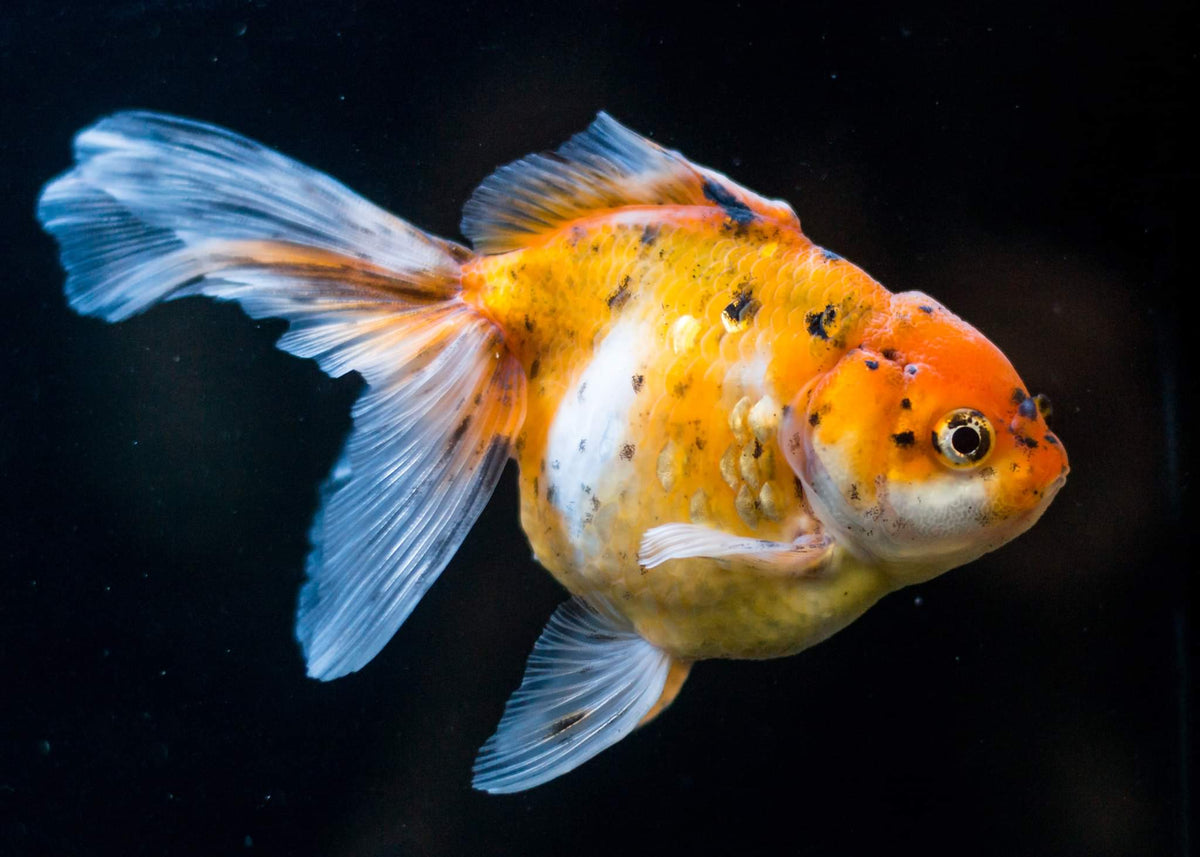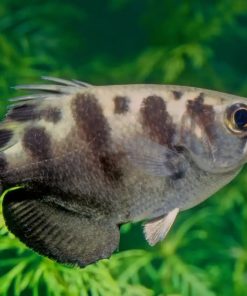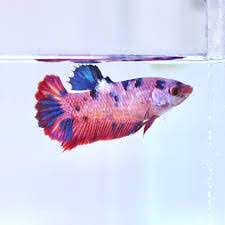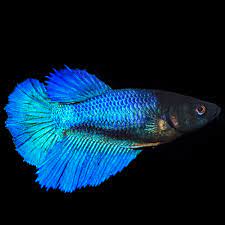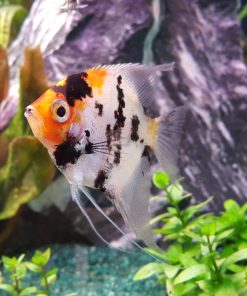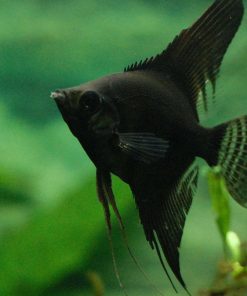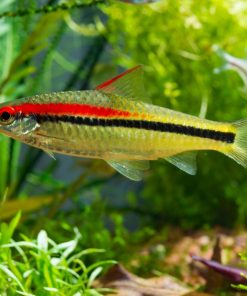Goldfish – Oranda Calico Aquarium Industries
$ 19,95 $ 11,97
Calico Oranda
Calico Oranda Goldfish are amazing because no two of these fish are the same. They make for one of the world’s most popular and readily available fish. The mixed colours and patterning achieved through their unique genetics make these very contrasting and enjoyable fish keep, these Calico Oranda are also a great alternative to the more basic strains like Red Cap Oranda.
Calico Oranda gets its name from the diverse variation of Dalmatian patterning and a range of colours ranging from black, white, red, orange, and blue. It’s almost like these colours were just thrown onto the fish in random order and this randomness is present in every fish! To elevate this even further they have mirror-like scales scattered through the body that reflect light like a kaleidoscope. These fish have a comical round body shape with bubble growths on the face called a wen, overall these are just very adorable and odd-looking fish to keep.
Whilst goldfish are cold water tolerant and can be kept in outdoor ponds, it is better to keep orandas indoors. These fish are not the best swimmers and are bred in tropical countries, they may not be able to hide swiftly from predators outdoors or even tolerate the near-freezing temperatures that comet goldfish can live in. Breeding these fish in captivity however is possible, sexing these goldfish is a difficult task but once males and females reach maturity they can show some chasing behaviours. Females may also appear to be larger when filled with eggs and have clear cheek plates whereas males tend to develop star-shaped bumps.
Tank Recommendations for Calico Oranda Goldfish
The Calico Oranda goldfish can get fairly big at 15 cm meaning that an individual fantail would need around 100 litres but a larger aquarium is always better because what is better than one calico oranda? Two calico oranda of course!
The thing to note however with Calico Oranda goldfish is that, though they have stunning fins, they are not the best swimmers so a slower flow is better. A sand substrate is best as oranda will actively sift through the sand, smooth river stones can be added for further decoration. Sharp materials should be avoided in the aquarium like pointy driftwood as oranda goldfish can easily get injured by them.
Suitable Tank Buddies
Calico Oranda are great fish as they are not aggressive in the slightest and can be kept with tank mates. Common tank mates they can be kept with are active and small cold-water tolerant fish. The goldfish however might eat fry produced by these smaller fish however they will be perfectly fine with adults. Fin nipping species however should be avoided entirely as they will make short work of the flowing fins of the goldfish.
Usually Compatible
Medaka icefish, paradise fish, giant danios, zebra danio, White Cloud Mountain minnows
Sometimes Compatible
Species that can be fin nippers like rosy barbs and also tropical species such as angelfish, dwarf cichlids, mollies, and species of a similar sort.
Rarely Compatible
Larger cichlids and fish that have a mouth large such as oscars, jaguar cichlids, and shrimp should also be avoided as fan tails will eat shrimp in an instant.
Feeding your Oranda
Feeding Calico Oranda should be a breeze, they should immediately take to any aquarium food practically within 24 hours of being added to their new home. Having other fantails as well will cost their confidence making them an almost ravenous pack when feeding (all friendly though). Slow-sinking foods would be best as oranda have been known to at times get swim bladder issues after frantically gulping for food at the surface. Good quality pellets or flakes that are rich in algae or spirulina content are best to suit their herbivorous diet.
- Species – Carassius Auratus (Oranda)
- Common Name – Calico Oranda
- Origin – East Asia
- Diet – Herbivour
- PH Range – Alkaline 6.5 – 7.5
- Water Type – Hard
- Temperature – 10-24
- Breed Type – Egg Scatter
- Current Size – approximately 8cm (Grows to approximately 30cm)
- Sex – Un-sexed
Fast Shipping and Professional Packaging
Because of our long-standing relationship with UPS FedEx DHL as well as other leading global carriers, we can offer a variety shipping options. Our warehouse staff is highly skilled and will wrap your goods in accordance with our exact and precise specifications. Your goods will go through a thorough inspection and be adequately secured before being shipped. We ship to thousands customers every day from all over the world. This demonstrates our dedication to become the biggest online retailer in the world. Both Europe as well as the USA have distribution and warehouse centers.
Note that orders containing more than one item are processed according to the particular item.
Before shipping, we will inspect the ordered items thoroughly. Today, the majority of orders will be delivered within 48 hours. The delivery time is estimated to be between three and seven days.
Returns
Due to the multiple parties involved, including the factory and the warehouse, we're unable to completely manage our stock. Therefore, the actual inventory could change at any time. It's possible that the stock may run out after your order has been processed.
Our policy is for 30 days. If you don't receive your product within 30 days, we are not able to issue a refund or an exchange.
Your item should be in its original packaging and in good condition. It must also not be used. The item must be returned in the original packaging.
Related products
Freshwater tropical fish
Freshwater tropical fish
Apistogramma – Cacatuoides Mega Orange PAIR Bundarra Tropical Fish Farm
Freshwater tropical fish
Freshwater tropical fish
Freshwater tropical fish
Freshwater tropical fish
Freshwater tropical fish
Freshwater tropical fish
Freshwater tropical fish
Freshwater tropical fish
Apistogramma – Agassizii Fire Red PAIR Bundarra Tropical Fish Farm
Freshwater tropical fish
Freshwater tropical fish
Freshwater tropical fish
Freshwater tropical fish
Freshwater tropical fish
Angelfish Bulgarian Seal Point 4cm Bundarra Tropical Fish Farm
Freshwater tropical fish
Freshwater tropical fish
Freshwater tropical fish
Freshwater tropical fish
Freshwater tropical fish
Freshwater tropical fish
Freshwater tropical fish
Freshwater tropical fish
Freshwater tropical fish
Freshwater tropical fish
Freshwater tropical fish
Freshwater tropical fish
Freshwater tropical fish
Freshwater tropical fish
Angelfish Rio Nanay Peru Altum F1 5cm Bundarra Tropical Fish Farm
Freshwater tropical fish
Freshwater tropical fish
Apistogramma – Agassizii Double Red PAIR Bundarra Tropical Fish Farm
Freshwater tropical fish
